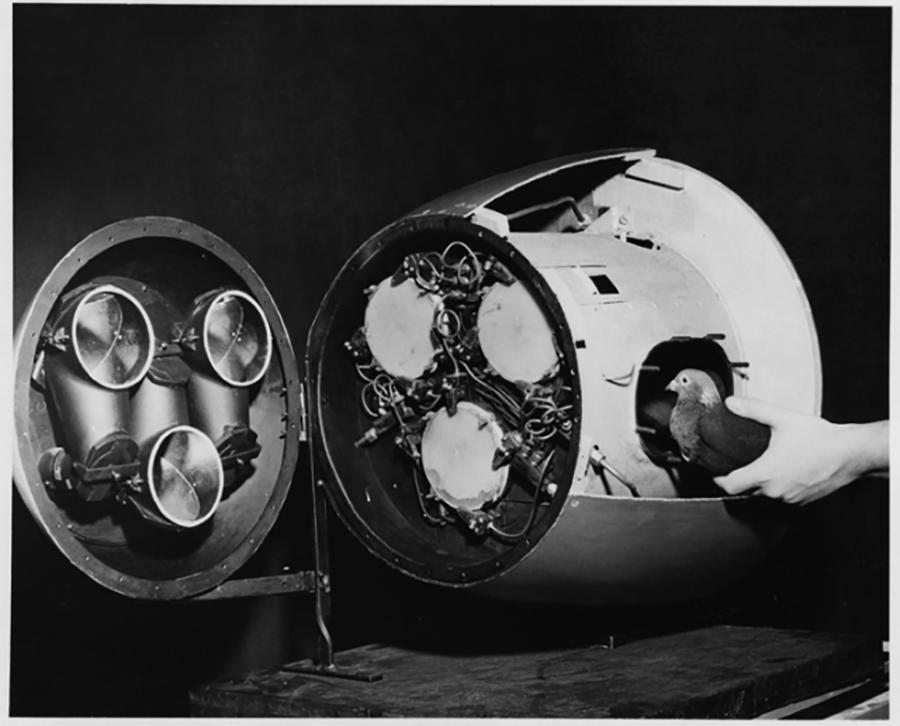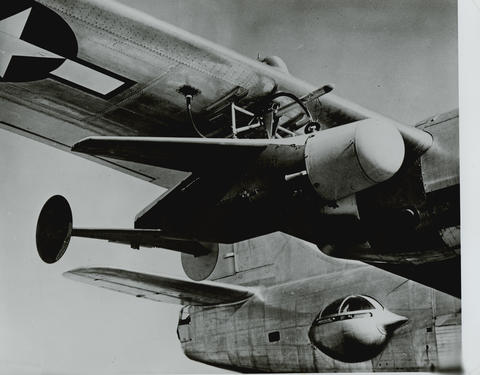Taking Measure
Just a Standard Blog

Nose cone of NIST glide bomb showing the three-pigeon guidance system.
During World War II, NIST was among those working intensely to develop guided weapons to help the Allies win the war. But before the advent of satellites and GPS, laser targeting or even radar, how would one guide a bomb?
Why, trained pigeons, of course.
‘Stupid’ bomb
Air bombs of that era were “dumb.” Once dropped, their paths could be altered by the wind. To accurately hit a target, bombers had to fly low, which increased the risk of being shot down. Flying at a higher altitude was safer, but required dropping more bombs to increase the chances of a hit. This was inefficient, expensive and led to more collateral damage.
At the request of the U.S. Navy, NIST (at that time called the National Bureau of Standards or NBS) developed a glider that could carry a 450-kilogram (1,000-pound) bomb and a servomechanism to move the glider’s wings and steer the bomb to its target.
All they needed now was a guidance system to tell the servomechanism what to do.
A first attempt proved unsuccessful. Under contract with the U.S. Navy and overseen by NIST, engineers from RCA Corp. installed a television camera to broadcast images back to a ground operator who would remotely steer the bomb. But television technology was still in its infancy in the 1940s, and there was too much interference for the signal to be effective.
Smart birds
It was at this point that an unusual solution to the problem emerged from an unlikely source: the famed University of Minnesota experimental psychologist B.F. Skinner. Skinner had heard of the guidance system problem from colleagues in the university’s engineering department. His proposed solution—trained pigeons—was as ingenious as it was strange. As he later explained, “I watched a flock of birds lifting and wheeling in formation [in the sky]. Suddenly, I saw them as ‘devices’ with excellent vision and extraordinary maneuverability. Could they not guide a missile?”
Skinner’s specialization was in the behavioral conditioning of animals. That is, he studied how to influence the behavior of animals by offering or withholding rewards.
For his pigeon idea, Skinner designed a harness that would hold a pigeon’s body and wings while allowing its head and neck to move freely. The pigeons were then given a pellet of grain when they pecked at an image of a ship or building placed in front of them. By gradually extending the time between the pigeon’s peck and its food reward, Skinner trained the birds to peck furiously at the image as it moved about. Eventually, his trained pigeons could peck 10,000 times in 45 minutes without stopping—much longer than the time needed for a falling bomb to reach its target.
To translate the pigeons’ pecks into a means to steer the bomb, Skinner and colleagues built a screen with a conductive surface and attached a gold electrode to the end of the bird’s beak. A lens in the nose of the glider-bomb would project an image of the ground below onto the conductive screen. When the trained bird inside the nose of the glide bomb pecked at a target it saw on the screen, it sent electrical signals to the servomechanism controlling the wings. Pecks to the left or right on the screen steered the bomb in that direction while pecks at the center told the bomb to stay on its current course.
In tests using projections from actual combat films, the system worked perfectly.
To help the birds acclimate to the vibrations and noise they would experience inside a falling bomb, Skinner used “special reinforcements” in the form of hemp seeds, which the pigeons found “particularly delectable.”
Unimpressed brass
Skinner gave multiple demonstrations of his pigeon guidance system to the military and to the MIT scientists who, along with NIST, were leading the guidance system research. While all agreed that the system worked, they remained hesitant about putting pigeons in control of their bombs.
Given the pressing need for a guidance system during a time of war and the failures of other attempted guidance technologies, modern historians have speculated that resistance to Skinner’s idea was due to a lack of “outside-the-box” thinking on the part of the project leaders. “Clearly [they] had trouble accepting a psychological approach to an engineering problem,” one historian wrote.
Skinner himself amusingly commented on one of the challenges to his idea: “We had begun to realize that a pigeon was more easily controlled than a physical scientist serving on a committee. It was very difficult to convince the latter that the former was an orderly system. We, therefore, multiplied the probability of success by designing a multiple bird unit.” To convince the physical scientists that the pigeon system would be reliable, Skinner gave his pigeon a set of co-pilots. Three pigeons would now steer the bomb. It would take at least two separate birds “agreeing” on a target, by pecking at the same image, to steer the bomb.
Bat missiles
Despite the success of Project Pigeon, pigeon-piloted bombs were never used in WWII. Instead, the Navy brass decided to go with a radio-based echolocation guidance system developed by Western Electric Co., and the NIST-built glide bomb saw action in the Pacific toward the end of WWII. Because it's guidance system worked similarly to the way a bat navigates, the glide bomb became known as the Bat.

Skinner wouldn’t be the only person from a seemingly unrelated field to take an interest in guided weapons during WWII. One problem with the radio-based guidance system—a problem that would have been avoided if Skinner’s pigeon system had been used—was that the enemy could easily jam the radio signal. Improbably, a solution to the jamming problem was designed (and patented!) by famous Hollywood film actress Hedy Lamarr and American avant-garde composer George Antheil. Though their invention arrived too late to be used in the Bat, their work would be incorporated into later guided-weapons technologies.
One element of Project Pigeon is still with us today. The conductive touchscreen display technology the pigeons used made its way into early radar consoles and is the ancestor of our modern touchscreen phones and tablets.
So, think about Skinner and his trained pigeons the next time you find yourself pecking at your smartphone, searching for a delectable little electronic reward.
About the author
Related Posts
Comments
Cool seems that they should of taken it more serious
I admire technology; I'm going to ask a question I hope I can get a reply on:
in this test and innovation: To whom goes most of the credit, and whom couldn't have done it without the other one: The Pigeon or The scientist ?
And There is more to the story, while the pigeon was in the Laboratory The scientist, without any other effort except Observation ; discovered The Pigeon could do much much more, What matters the most to the Humanity in such case: Measuring How accurate The Pigeon nose is in the 1st Technique or discover How many more techniques can The Pigeon be useful in innovating ?
I sincerely would appreciate an answer;
Antoine Germanos






My father worked with NIST at the time supervising bombsight and gun sight development for the navy. Skinner's nickname was the "Cat Bomber" because he screamed that he could do it with cats too as security dragged him out of the building. He had the ear of Eleanor Roosevelt so they conceded in proceeding with his theory so not to upset the political class.
The science of feedback theory was developed during that time as TV guided bombs were a guarantee miss due to the reaction time of the operators not because the signal jamming.